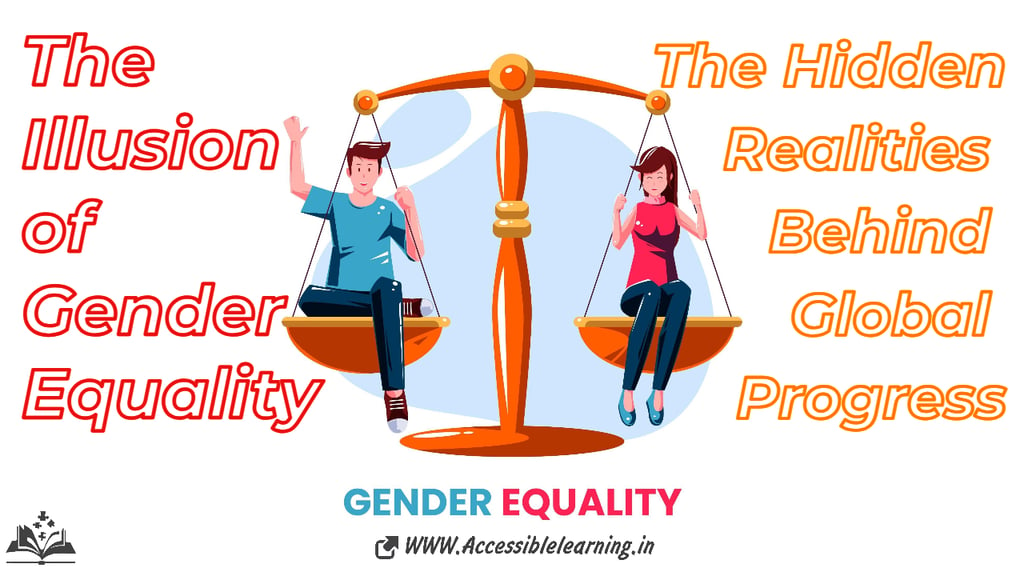
Unveiling the Hidden Realities Behind Global Progress!?
The hidden realities of gender inequality, where global progress is often a sham to hide the everyday struggles faced by all genders. Learn the truth behind the illusion of gender equality in this thought-provoking article.
NEPOTISM/SOCIAL ISSUESAWARE/VIGILANTGLOBAL ISSUESABUSE/VIOLENCE
Sachin K Cahurasiya
8/25/20244 min read


When we look at gender equality on a global scale, it’s easy to feel optimistic. We see more women in leadership positions, stronger laws against discrimination, and a growing awareness of gender issues. But these achievements, while important, can sometimes paint an incomplete picture. The truth is that when we dig deeper into everyday life, gender inequality is still very much alive, affecting everyone—women, men, and non-binary people alike.
This article will explore how gender inequality affects different genders in unique ways and why it’s important to understand these complexities in order to create real change.
The Global Illusion: A World of Equal Opportunity?
On the surface, it may seem like the world is becoming more equal. We see headlines celebrating women breaking glass ceilings and more men stepping forward as allies in the fight for gender equality. However, this focus can sometimes overshadow the struggles that still continue for all genders.
For example, while women are increasingly visible in leadership roles, they often face tighter scrutiny and higher expectations than their male counterparts. This creates a phenomenon known as the “glass cliff,” where women are more likely to be placed in risky or precarious positions.
Meanwhile, men are often under pressure to fit into narrow definitions of masculinity, which can discourage emotional openness and seeking help for mental health problems. This pressure contributes to higher rates of male suicide and substance abuse, showing that gender inequality goes both ways.


The Daily Reality: Gender Inequality in Everyday Life
While global statistics may show progress, gender inequality is very common in everyday life. It’s not just about who earns more or has more power; it’s about what roles we are expected to play and what limitations are placed on us because of our gender.
For women, this often means doing a lot more unpaid labour at home alongside work, from cooking and cleaning to caring for children or elderly family members. This “second shift” not only limits career opportunities but also perpetuates the gender pay gap.
Men, on the other hand, face their own challenges. Society often expects them to be the main breadwinners and to suppress their emotions to appear strong. These stereotypes can lead to stress, anxiety, and a reluctance to pursue careers in fields traditionally considered "feminine," such as teaching or nursing.
Non-binary and gender non-conforming individuals often find themselves in a world that does not fully understand or respect their identity. This can create challenges in accessing healthcare, education, and employment, further complicating their experience of gender inequality.
Gender-Based Violence: A Universal Issue
Gender-based violence is a global crisis that affects all genders, although in different ways. While women are often the focus of discussions on gender-based violence—and rightfully so, as the rates of domestic abuse and sexual violence they face are disproportionate—men are also victims. Men are more likely to experience violent crime and are often discouraged from reporting domestic abuse due to social stigma.
For non-binary and transgender individuals, the risk of violence is even greater. They face not only physical violence but also systemic discrimination, which can make it difficult to find safe spaces and access necessary services.
Addressing gender-based violence requires a comprehensive approach that acknowledges the experiences of all genders and works to dismantle the harmful stereotypes that perpetuate this violence.
The Role of Media and Culture in Gender Inequality
Media and culture play a powerful role in shaping our understanding of gender. They can either reinforce harmful stereotypes or challenge them, opening up new possibilities for how we view ourselves and others.
Unfortunately, traditional media often promotes narrow definitions of gender roles. Women are often depicted in roles that emphasize their appearance or caring abilities, while men are shown as leaders, protectors, or aggressors. These portrayals not only limit individuals’ opportunities but also reinforce a cycle of inequality that affects all genders.
For a more equitable society, media and culture must evolve to portray a broader range of gender experiences, challenge outdated norms, and celebrate diversity.


Bridging the Gap: From Global Rhetoric to Social Change
To truly address gender inequality, we need to move beyond global rhetoric and focus on the everyday realities faced by people of all genders. This means creating policies that challenge harmful gender norms, providing support to victims of gender-based violence regardless of gender, and promoting equal opportunities in all areas of life.
Education is the key to this change. By teaching children about gender equality from an early age, we can begin to break down the stereotypes that contribute to inequality. Media and cultural institutions also have a responsibility to portray gender in ways that are diverse and empowering.
Gender inequality is a complex issue that affects everyone—women, men, and non-binary individuals. While global narratives often highlight progress, the reality is that there is still much work to be done. By acknowledging and addressing the full spectrum of gender inequality, we can work toward a future where everyone has the opportunity to thrive, regardless of their gender.
Subscribe to our newsletter
All © Copyright reserved by Accessible-Learning
| Terms & Conditions
Knowledge is power. Learn with Us. 📚


